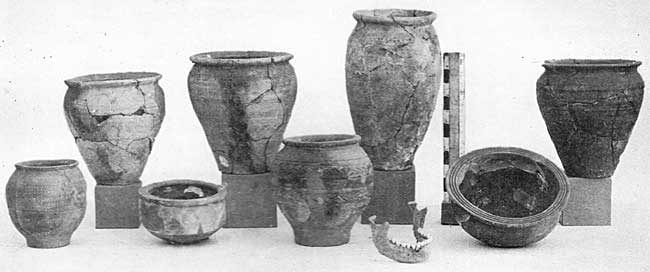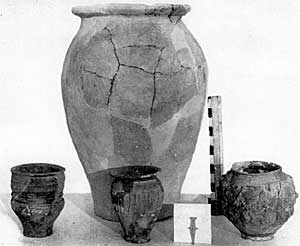In another old ditch of a road at right angles to the last, running to the S.W. angle, even older pottery was found (Plate IX.), such as the bases of pedestal urns, a tall narrow urn which is entirely late-Celtic in shape, early cooking-pots, Rustic and rouletted urns, etc.

PLATE IX. Pottery from ditch of road to S.W. angle of camp.
An interesting human lower jaw occurred in this ditch of a young man with a very pronounced chin who had just cut his wisdom teeth, but a molar on the left side had suffered from a bad abscess. The ditch also contained a very early specimen of the hemispherical bowl (Form 37) of Sigillata which may be dated to the reign of Nero, together with still earlier fragments of the carinated bowl (Form 29). A wide bowl with reeded rim is on the other hand characteristic of the Nero-Vespasian period, and occurred in the upper part of the ditch together with much window-glass. A pit at the side of this ditch only contained the skeletons of no less than five dogs (apparently a kind of mastiff), which had probably been wounded in hunting and then destroyed ; one of them had a fractured skull.
In a drainage-ditch leading from a building (probably a stable) into this cross-road I found a coin of Claudius and a brooch of bronze, tinned to resemble silver, of exactly the same type as a tinned brooch from the camp of Hod Hill in Dorset,1 only occupied by the Romans from 40-50 A.D. This ditch also contained much early pottery of this date (Plate X.), e.g., a large store-jar with combed pattern, probably used for corn, which only occurs in the early layers before Vespasian; a barrel-shaped beaker, quite Augustan in character; a piece of the cylindrical bowl (Form 30) of Sigillata in the style of the Claudian potter NAMVS of South Gaul; Rustic and rouletted urns, carinated urns, etc.

PLATE X. Pottery and fibula from a Claudian ditch.
Quite recently I have discovered the baths outside the western rampart, but situated between the outer ditches. It was an extensive building, the northern wall being 130 feet in length, and there had been much re-construction at different times, but it will take a long time to expose it fully. Although it has been greatly robbed of stone the N.W. corner still shows massive walls, 2½ feet in thickness, with several horizontal courses, with rough floors of fine concrete (opus signinum). There is evidence of a conflagration shown by a thick layer of charcoal with burnt roofing-tiles, and this is overlain by a concrete floor at the base of which were a few fragments of Sigillata of the Hadrian-Antonine period. When this building is fully exposed and examined layer by layer it will probably throw much light on the history of MARGIDUNUM.
The only evidence of religious worship on the site is a fragment of a pipeclay statuette of Venus (from Central France), which must have originally stood in a small domestic shrine.
(1) British Museum Guide to the Antiquities of Roman Britain, Fig. 56.
